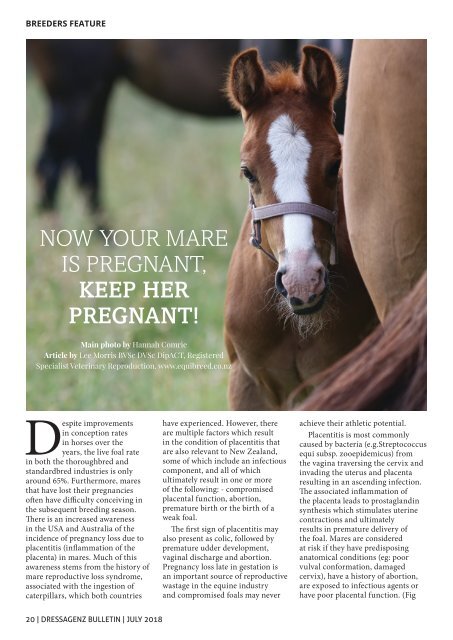Dressage NZ Bulletin
Issue 24 July 2018
Issue 24 July 2018
You also want an ePaper? Increase the reach of your titles
YUMPU automatically turns print PDFs into web optimized ePapers that Google loves.
BREEDERS FEATURE<br />
NOW YOUR MARE<br />
IS PREGNANT,<br />
KEEP HER<br />
PREGNANT!<br />
Main photo by Hannah Comrie<br />
Article by Lee Morris BVSc DVSc DipACT, Registered<br />
Specialist Veterinary Reproduction. www.equibreed.co.nz<br />
Despite improvements<br />
in conception rates<br />
in horses over the<br />
years, the live foal rate<br />
in both the thoroughbred and<br />
standardbred industries is only<br />
around 65%. Furthermore, mares<br />
that have lost their pregnancies<br />
often have difficulty conceiving in<br />
the subsequent breeding season.<br />
There is an increased awareness<br />
in the USA and Australia of the<br />
incidence of pregnancy loss due to<br />
placentitis (inflammation of the<br />
placenta) in mares. Much of this<br />
awareness stems from the history of<br />
mare reproductive loss syndrome,<br />
associated with the ingestion of<br />
caterpillars, which both countries<br />
have experienced. However, there<br />
are multiple factors which result<br />
in the condition of placentitis that<br />
are also relevant to New Zealand,<br />
some of which include an infectious<br />
component, and all of which<br />
ultimately result in one or more<br />
of the following: - compromised<br />
placental function, abortion,<br />
premature birth or the birth of a<br />
weak foal.<br />
The first sign of placentitis may<br />
also present as colic, followed by<br />
premature udder development,<br />
vaginal discharge and abortion.<br />
Pregnancy loss late in gestation is<br />
an important source of reproductive<br />
wastage in the equine industry<br />
and compromised foals may never<br />
achieve their athletic potential.<br />
Placentitis is most commonly<br />
caused by bacteria (e.g.Streptococcus<br />
equi subsp. zooepidemicus) from<br />
the vagina traversing the cervix and<br />
invading the uterus and placenta<br />
resulting in an ascending infection.<br />
The associated inflammation of<br />
the placenta leads to prostaglandin<br />
synthesis which stimulates uterine<br />
contractions and ultimately<br />
results in premature delivery of<br />
the foal. Mares are considered<br />
at risk if they have predisposing<br />
anatomical conditions (eg: poor<br />
vulval conformation, damaged<br />
cervix), have a history of abortion,<br />
are exposed to infectious agents or<br />
have poor placental function. (Fig<br />
20 | DRESSAGE<strong>NZ</strong> BULLETIN | JULY 2018


